|
"Cemeteries today play many roles in the lives
of the living. In a relentlessly urban environment, they are
used as visitor attractions peaceful and green open spaces, outdoor
art galleries, sites of pilgrimage, places to play, to sleep,
to have sex, to think, to walk the dog, to hang out with friends,
or maybe to have a beer. But this can sometimes be vulnerable
to development plans and the demands for new housing, roads and
services for the living. With the intense competition for space
in London today, little space is available for the living, let
alone the dead."
London is running out of burial space.
Inner London boroughs have on average seven years' burial space
left. Two of them, Hackney and Tower Hamlets, have no space left
at all. With intense competition for space, do we still have
room for the dead, and if so, where?
Photographs of crematorium interiors and oral recordings of people
involved in the disposal of the dead offered insight into professions
rarely discussed in public.
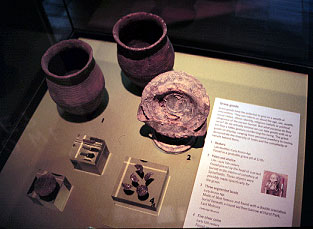
Objects on display explored the many
facets of our attitudes to death. They ranged from an Early Bronze
Age cremation urn and recently excavated Roman grave goods to
an environmentally friendly contemporary cardboard coffin. 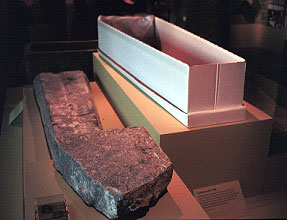
An exhibition of wicker coffins in 1875
Francis Seymour Haden's 'Earth to 'Earth' system was based on
allowing the body to decay naturally. He believed that burial
in wooden coffins resulted in 'festering tenants inperpetuity
of the soil' and that cremation would needlessly pollute the
air. He promoted the use of easily degradable coffins, notably
wicker coffins, arguing that they would enable burial in the
same land every five or six years.
|
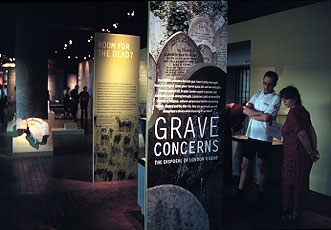
This display explored issues we would
rather not face and asked the question - what will happen to
our bodies when we die?
How should Londoners dispose of their
dead? People came and aired their views at a debate on 6 September,
when the motion was: 'Must London face up to reusing graves?'
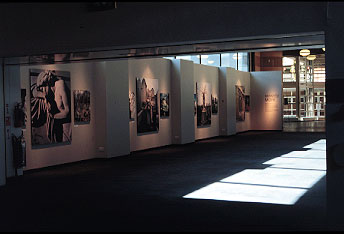 Memento Mori - Contemporary
photography by Agustin Amate Bonachera Memento Mori - Contemporary
photography by Agustin Amate Bonachera
31 August 2000 to 8 October 2000
In a series of photographs of Victorian and Edwardian sculpture
in the cemeteries of London, Agustin Amate Bonachera explores
the transient nature of human existence, capturing a society's
belief in the divine and immortal.
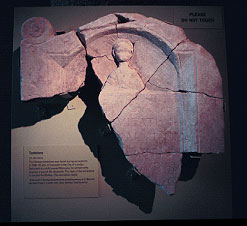
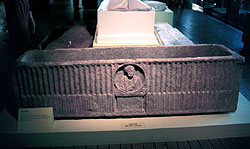
|
|
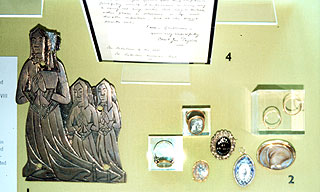
Coffin plate and mourning jewelery
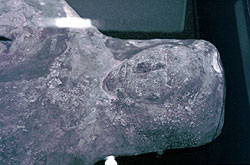
|
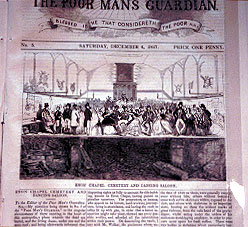
Enon Chapel Cemetery and Dancing Saloon, in The Poor Man's
Guardian,1847
Between 1822 and 1842 the Minister of Enon Street Baptist
Chapel in Clements Lane Facilitated the disposal of an estimated
10?12,000 people in its cellar removing bodies when more space
was needed this edition of The Poor Man's Guardian featured responses
to an earlier report which described how while dances were held
in the chapel above in the cellar below on all sides lay human
remains broken coffins and other emblems of decayed mortality
|
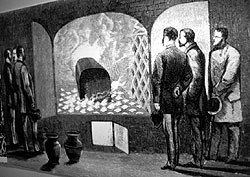
Sir Henry Thompson demonstrating :
a cremation oven in 1874
Published in illustreret tidende, 1874
In 1874 Sir Henry Thompson, surgeon to Queen Victoria, founded
the Cremation Society and began to promote cremation. He argued
that it was a more sanitary method of disposal and less space
consuming than burial, as well as being more economical. After
initial Home Office hesitancy, the first official modern cremation
of a person took place in 1885 and a Cremation Act was passed
|
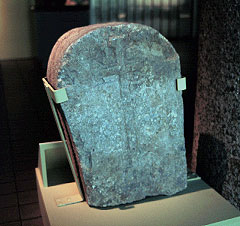
Headstone 12th?13th century
This headstone, of Purbeck marble, was found during excavations
on the site of ] Poultry. The headstone came from the graveyard
of St Benet Sherehog, a small parish in the City of London. On
one side a cross is carved, on the other side an inscription
reads:
'H[ic] iacet in tumbo coniu[n]x alicia petri'
'Here lies in this tomb, Alice the wife of Peter' |
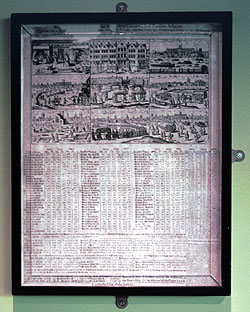
A Bill of Mortality, published weekly summary of deaths during
the Great Plague |
Disposal of plague
victims
One in three Londoners died during the Great Plague of London
in 1665.
Myths and misconceptions have developed concerning the location
and methods of disposal of victims.
Evidence suggests that, contrary to popular belief the process
of burying the dead during the plague was well managed, with
bodies being carefully laid out and buried in shrouds or coffins.
Where possible existing graveyards coped with the rising numbers
of dead. As yet, no specific plague pits have been excavated
for the 1665 plague. |
In loving memory of West Norwood Cemetery,
by Geoffrey Manning, 1989
Published by the Norwood Society, this booklet was a guide to
the most significant memorials in West Norwood Cemetery. Since
Lambeth Council purchased the cemetery in 1965, a 'lawn clearance'
programme has resulted in the removal of over 10,000 memorials.
The council is now working to repair and restore some of them.
It also resold over 900 graves following 1970s legislation permitting
municipal cemeteries to sell unused burial space within existing
graves over 75 years old.
In 1994 a Southwark church court had judged the resale of graves
at west Norwood, as it was originally a private not a municipal
cemetery, to be illegal |